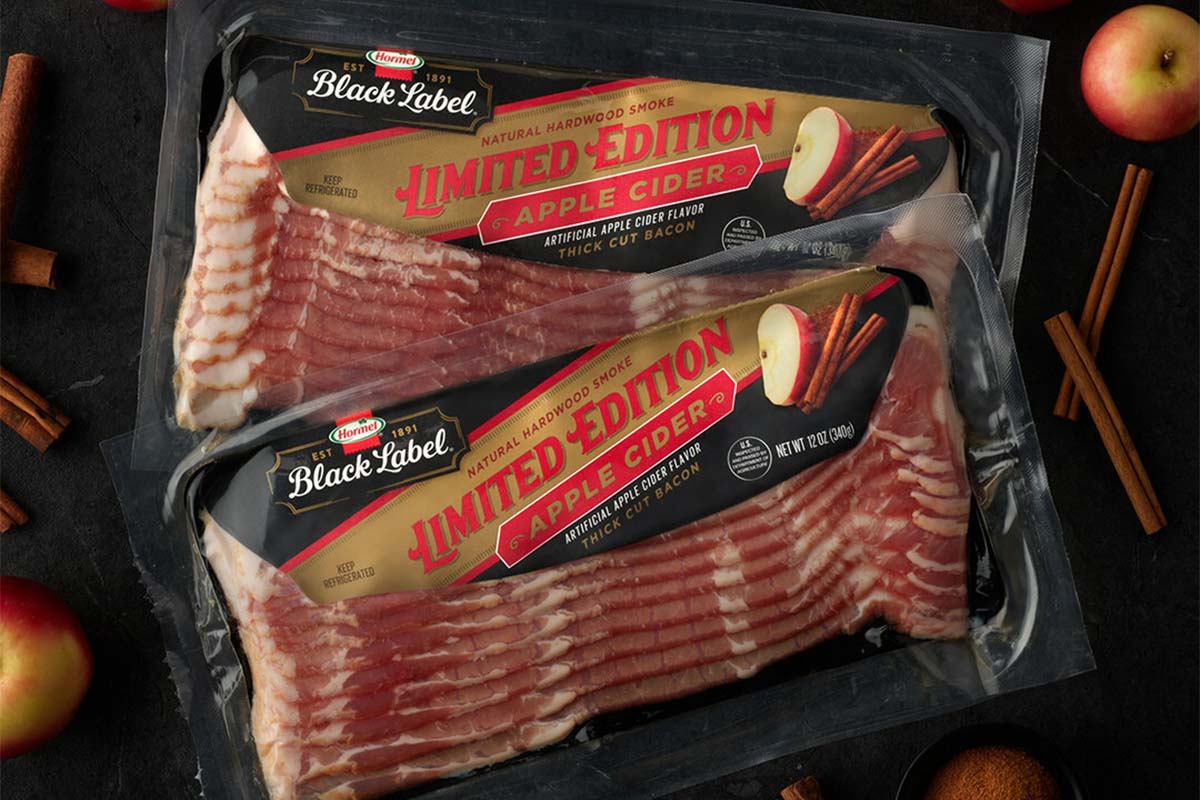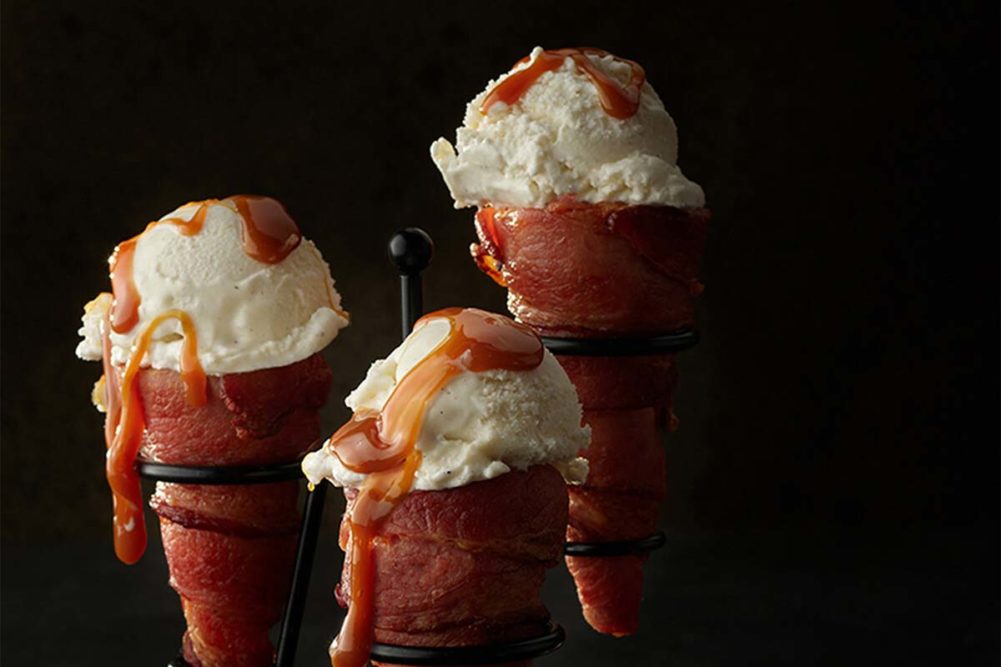According to the 2023 Bacon Market Report, the global bacon market size reached $68.5 billion in 2022. Looking forward, the publisher expects the market to reach $86.6 billion by 2028. There seems to be no end for our love of bacon in all its forms.
According to US Department of Agriculture (USDA), bacon is the cured belly of a hog. However, today’s bacon goes beyond pork and beyond the belly. The most common type of bacon is referred to as “streaky” bacon, because it is sold in long narrow strips cut crosswise from the belly that has veins of pink meat within the white fat. Other types of bacon must add descriptors before the term “bacon” to identify and market items — like pork shoulder bacon.
Same word, different cuts
Canadian bacon also called back bacon, which are circular slices from the loin, typically have less fat than other types of bacon. Irish bacon or rashers is similar to Canadian bacon, but it has a layer of fat around the outside of the slice. Cottage or buckboard bacon is made from the pork shoulder, which makes it meatier than bacon from the belly. Pancetta is a type of Italian bacon made from pork belly and cured, but typically not smoked, with spices like clove, juniper or rosemary. Speck bacon is made from deboning and flattening the hind leg which is then brine cured before smoking and air drying.
Beef bacon is produced from various cuts of beef that are cured, smoked and sliced to look like regular streaky bacon. Beef bacon must also include a common or usual name, like cured and smoked beef plate or hickory smoked beef round. Poultry bacon has similar requirements. For example, it could be labeled as smoked turkey bacon and include the common name of turkey thighs chopped and formed or turkey dark meat chopped and formed.
Bacon also has unique packaging requirements. USDA’s labeling regulations stipulate the size and location of a transparent window to allow consumers to view the bacon slices. For shingle-packed sliced bacon, the transparent window must reveal at least 70% of the length (longest dimension) of the representative slice, and this window shall be at least 1-1/2 inches wide. The transparent window shall be located not more than five-eighths inch from the top or bottom edge of a 1-lb or smaller package and not more than 3/4 inch from either the top or bottom edge of a package larger than 1 lb. For stack-packed sliced bacon, the transparent window also shall be designed to reveal at least 70% of the length (longest dimension) of the representative slice and be at least 1-1⁄2 inches wide.
One word that is often found on bacon packages is “premium.” There is no definition of “premium” as it relates to most products, especially bacon, but the connotation is that items with this descriptor are above the rest. In the bacon industry, there are two quality assurance measurements that are used to signify a #1 bacon slice. First, the secondary lean (the cutaneous trunci muscle) shall be at least 50% of the width of the slice. Second, the minimum profile thickness shall be at least 3/4 inch at any point. Slices that do not meet both requirements are termed a #2 slice. Most national brands of bacon will select slices deemed as #1 for their products with #2 slices marketed as private or other brands. During the slicing process, those slices that are near the shoulder or ham end are often referred to as “ends and pieces” and are marketed to those using them for seasoning items such as beans or to make into commercial bacon bits and pieces.
 USDA's regulations stipulate the size and location of a transparent window in packaging to allow consumers to view the slices. (Source: Hormel Foods Corp.)
USDA's regulations stipulate the size and location of a transparent window in packaging to allow consumers to view the slices. (Source: Hormel Foods Corp.)Challenges and choices
Just as with many other products, bacon has faced challenges associated with an increase in consumers seeking products with added nutritional benefits, clean labels and sustainably produced. A quick look in retail cases demonstrates that the bacon industry can fulfill consumer demands for these products.
If today’s consumers do not want traditional bacon, they have multiple choices to select from including, but not limited to: 1) uncured bacon, 2) all-natural bacon, 3) sugar-free bacon, 4) no antibiotics, ever, 5) no added hormones, 6) no artificial ingredients, colors, or preservatives, 7) crate-free, 8) humanely raised, 9) from pork raised with 100% vegetarian feed, and of course, 10) gluten-free. On top of these descriptors, some companies include information about their carbon footprint, such as produced by a “carbon neutral company.”
The choices do not stop there. Consumers can also select the type of wood used to smoke the bacon. The most popular woods are hickory, apple and maple with a few brands offering mesquite as an option. Hickory is the traditional wood used to smoke many pork items, especially bacon, and it provides a stronger flavor, while apple and maple provide milder, sweet flavors. Then, consumers can choose thin sliced, thick sliced or slabs. Plus, bacon is sold as raw, ready-to-cook; raw, ready-to-microwave; or as fully cooked, ready-to-eat.
Versatile ingredient
Marketers continue to look for ways to create “new and improved” items hoping to increase incremental sales for a category. Bacon is not immune to this strategy as several types of bacon in addition to smoke flavors have been introduced over the years.
Dry-cured bacon is found in many retail outlets harking back to the days when bellies were simply rubbed with the salt and cure ingredients and hung for days or weeks before smoking to complete the process. Adding black pepper to the surface of the bellies before smoking so that the slices have pepper around the edges is a unique style now offered in the marketplace. H-E-B has a small-batch concept that currently includes “Churro, Cinnamon & Sugar Seasoned Bacon” for those who never dreamed that you could cross bacon and churros in one product.
An additional use of bacon is for wrapping various food items. “Bacon-wrapped” as an adjective is seen in many recipes and menus, and there is no end in sight for what bacon can be added to: beef (filet mignon), pork (tenderloin), poultry (chicken breast, turkey), vegetables (asparagus, green beans), and seafood (shrimp, scallops). One of the most popular items today is “bacon-wrapped jalapeño poppers” where jalapeños are sliced lengthwise, cleaned of seeds, stuffed with cream cheese, and wrapped with bacon before grilling, smoking or baking. Poppers provide such an array of flavors and textures, and bacon just seems to top it off.
We cannot forget that bacon is also being added to waffles and cookies, candied for garnishes and used as an ice cream topping. Thinking of bacon toppings on vanilla ice cream is a fantastic way to conclude this discussion of one of America’s favorite foods.



